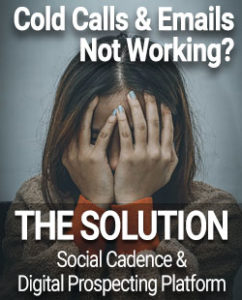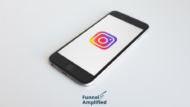If you are in sales or marketing, you’ve heard the term “Digital Sales,” or “Social Selling” used as a buzz phrase. In a business world in which 65% of Global GDP will be digitized by next year, businesses are prioritizing digital social selling. Nearly half of the articles you’ll see in any sales-focused media outlet will likely have one of those two phrases in the title. But what does that mean?
Breaking it down, digital sales is simply utilizing digital media and social networks to sell. And, taking it a step further, social selling is the process of prospecting, relationship building, and selling through those digital assets. As businesses look at the most important activities for sales success, social sales activities are often prioritized.
The appeal to digital sales is obvious. Digital, and social networks, are where customers spend their time. Beyond that, a focus on social selling allows for businesses to reach more people, in a much shorter time span, and in a strategically targeted way. It also shortens the sales cycle while decreasing the new customer acquisition cost.
However, the benefits go beyond this. Modern digital social selling also positively impacts more traditional sales activities and strategies.
How Digital Sales Activities Impact Traditional Sales Activities
For most industries, the concept of, “dialing and smiling,” was left at the boiler room call center of the ’80s and ’90s. And, just the same, the days of acquiring any email list, no matter the quality of the list, and mass spam emailing, were a thing of the early 2000s. However, sales calls and sales prospecting through email can have a place in the modern buyer’s journey; and, social selling activities help increase the result of those calls and emails.
How Digital Sales Activities Help Email Response Rates
 Email marketing and email cold prospecting is a tough activity these days. Aside from well-cultivated email lists of close contacts and current customers, the average email response rates have plummeted over the past decade.
Email marketing and email cold prospecting is a tough activity these days. Aside from well-cultivated email lists of close contacts and current customers, the average email response rates have plummeted over the past decade.
The average email open rate is anywhere from 12-25%, depending on your industry. This figure is for opted-in email addresses. The rate is around 2% for cold email addresses (an email address that has not opted in).
The average click-through rate of those who open an email is 2-5%. So, not only is getting someone to open an email a 1 out of 4 proposition at best, getting them to take the desired action once they open the email is even more of a statistical improbability. Social selling activities can help.
Digital Selling Helps Email Opens And Click-Through Rate
We’ve been using the phrase, “social selling activities,” and, “digital sales activities.” What we mean by these terms is any activity you take through any digital asset or social network when representing your business. This can be posting about your business on Facebook, replying to a Tweet, sending a LinkedIn connection request to a targeted prospect, or any other digital activity. These are activities you take online to prospect, build relationships, and drive sales.
These, sometimes seemingly mundane small online social actions, can have big effects on your email open rate and click-through rates. This happens for a few reasons:
1: Name Recognition:
People open emails from names they recognize. If you’ve interacted with a prospect through social media, even in a passive way (meaning no direct communication beyond liking a post or commenting on a post), they’re likely to recognize your name. When they recognize your name, even if just out of politeness or curiosity, they’re much more likely to open your email.
2: Relationship Building:
People are more likely to open an email, and to click links within an email when they feel they have a relationship with. These days, it does not take much for a prospect to feel they have a relationship with a person or a brand. If you’ve interacted in any direct way online, it is highly likely the prospect feels they have some type of relationship with you.
3: They’ve Qualified Themselves
While the first two reasons were likely obvious, this one is often overlooked. Modern buyers are smart. They value their online time. When they’ve seen your name repeatedly through your digital activity, they’ll get curious. They will click around. They’ll qualify, or disqualify themselves. Both are good outcomes for you. If they open your email, it is likely because they’ve already qualified themselves as a target prospect for you. They’ll be much more highly likely to click through or reply.
We’d like to note the part in which we said that the prospect might disqualify themselves. This is a positive. When a prospect takes themselves out of your prospecting pool, they’re saving you time and helping you to better target more ideal prospects.
Liking an Instagram post, commenting on a prospect’s corporate blog post, or simply adding a laughing GIF to a funny Facebook post may seem like a small action, but it helps build name recognition, build relationships, and it will increase your email open rate when you email that person. The same is true for cold call answer rates.
How Digital Selling Activities Helps Phone Call Response Rates
We got a bit clever with the term, “phone call response rate.” This term encompasses not just those who answer your calls, but those who return your call. These days, plenty of people keep their phones on silent and answer very few calls. The modern buyer likes to talk at their convenience, and through the method of their choice.
If a buyer does prefer or is at least warm to the idea of telephone calls, your social selling activities will benefit your cold calling and lead nurturing phone calls.
Social Selling Helps Phone Call Answer And Return Call Rates
The same reasons that a person is more likely to open your emails if you’ve engaged through digital media activities with them apply to phone calls.
The prospect is more likely to recognize your name, and if it appears on Caller I.D., they’re more likely to answer. If they’ve interacted with you online, and feel like they have some type of relationship with you, they’re more likely to answer or return your message. And, they’re likely to have qualified, or disqualified themselves, as a prospect prior to you calling. If they return your call, it is likely they have some interest.
Another factor to consider is social norms. When someone calls you, and you miss the call, it is a proper social norm to call them back. Or, as the modern buyer often prefers, they’ll at least text back. A person is highly unlikely to not reply or take some action when called by a name they recognize. This is especially true if you travel in somewhat of the same professional circles, and they’ve seen your name come up a few times on a social network
Practical Takeaway
The bottom line is, the more you engage in meaningful ways online with prospects, the more likely they are to open your emails and answer your phone calls. And, when they do, they’re likely to have already qualified themselves, or at the very least have some interest in either furthering their relationship with you or interest in the products or services you provide. Take advantage of this knowledge.
Set a goal of the number of actions you will take online with a prospect before you initiate an email, direct message, or phone call. We suggest 8-10. This can be as small a liking a post. Though, we do suggest adding in a few comment replies to posts of theirs and adding some personality or humor to your replies.
Once you’ve interacted with the prospect 8-10 times online, reach out directly to them. We’re confident you’ll get much better response rates, and as a results close more sales.

Thanks for reading. I typically write about modern selling, virtual selling, prospecting, sales reps reputation and how content helps all of these with modern buyers. My primary audience includes CEOs, CROs, CMOs, and other executives responsible for increasing bottom line. Post your questions in the comments section below and let’s discuss this!








